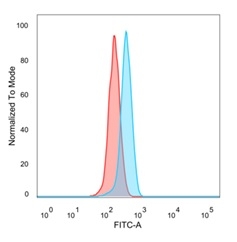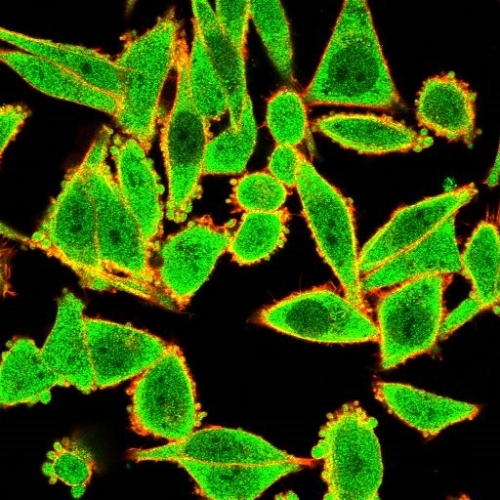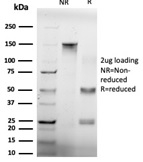Free Shipping in the U.S. for orders over $1000. Shop Now>>

Flow Cytometric Analysis of PFA-fixed HeLa cells. GTF2H2 Mouse Monoclonal Antibody (PCRP-GTF2H2-1B9) followed by goat anti-mouse IgG-CF488 (blue); unstained cells (red).

Immunofluorescence Analysis of PFA-fixed HeLa cells. GTF2H2 Mouse Monoclonal Antibody (PCRP-GTF2H2-1B9) followed by goat anti-mouse IgG-CF488 (green). Phalloidin counterstain (red).

Immunofluorescence Analysis of PFA-fixed MCF7 cells. GTF2H2 Mouse Monoclonal Antibody (PCRP-GTF2H2-1B9) followed by goat anti-mouse IgG-CF488 (green). Phalloidin counterstain (red).

SDS-PAGE Analysis Purified GTF2H2 Mouse Monoclonal Antibody (PCRP-GTF2H2-1B9). Confirmation of Purity and Integrity of Antibody.

Analysis of Protein Array containing more than 19,000 full-length human proteins using GTF2H2 Mouse Monoclonal Antibody (PCRP-GTF2H2-1B9). Z- and S- Score: The Z-score represents the strength of a signal that a monoclonal antibody (MAb) (in combination with a fluorescently-tagged anti-IgG secondary antibody) produces when binding to a particular protein on the HuProtTM array. Z-scores are described in units of standard deviations (SD's) above the mean value of all signals generated on that array. If targets on HuProtTM are arranged in descending order of the Z-score, the S-score is the difference (also in units of SD's) between the Z-score. S-score therefore represents the relative target specificity of a MAb to its intended target. A MAb is considered to specific to its intended target, if the MAb has an S-score of at least 2.5. For example, if a MAb binds to protein X with a Z-score of 43 and to protein Y with a Z-score of 14, then the S-score for the binding of that MAb to protein X is equal to 29.
Initiation of transcription from protein-coding genes in eukaryotes is a complex process that requires RNA polymerase II, as well as families of basal transcription factors. Binding of the factor TFIID (TBP) to the TATA box is believed to be the first step in the formation of a multiprotein complex containing several additional factors, including TFIIA, TFIIB, TFIIE, TFIIF and TFII. TFIIH (or BTF2) is a multisubunit transcription/DNA repair factor that possesses several enzymatic activities. The core of TFIIH is composed of five subunits, designated p89 (XPB or ERCC3), p62, p52, p44 and p34. Additional subunits of the TFIIH complex are p80 (XPD or ERCC2) and the ternary kinase complex composed of Cdk7, cyclin H and Mat1. Both p89 and p80 have ATP-dependent helicase activity. The p62, p52 and p44 subunits have been shown to be involved in nucleotide excision repair.
There are no reviews yet.